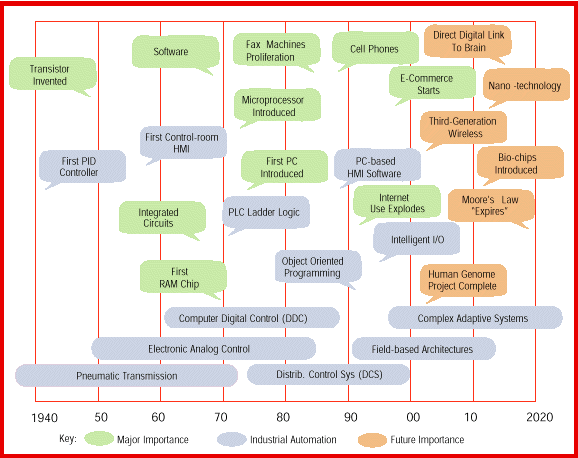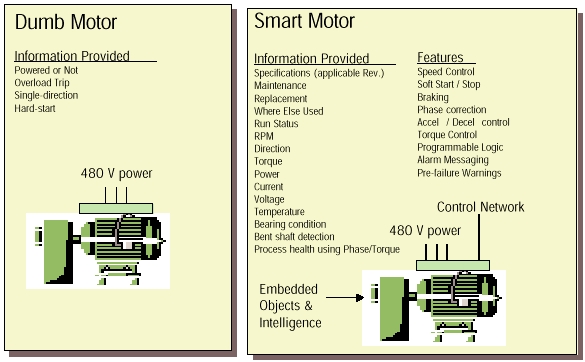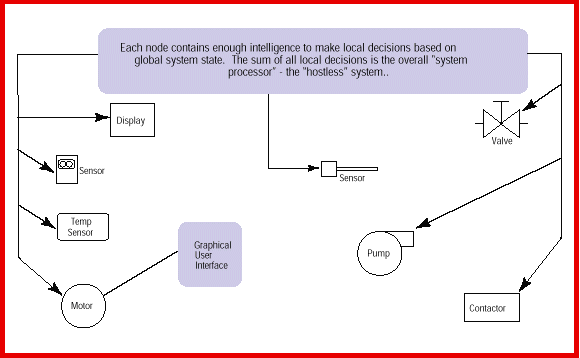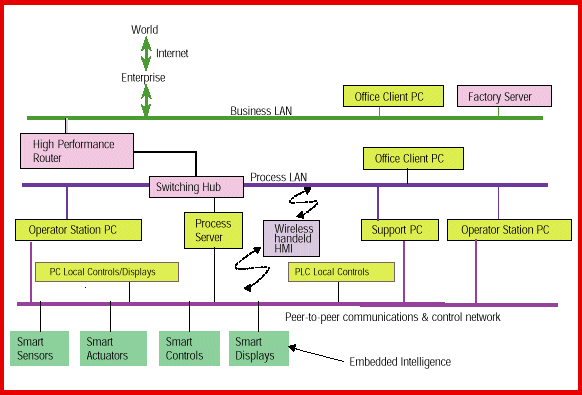|

Accelerating Change
As the millennium turns, change is occurring faster than ever before, caused primarily by technology advances. In the industrial controls business we moved during the last half of the past century from pneumatic controls (some still around) to electronics (vacuum tubes) to transistors to integrated circuits. Direct Digital Controls (DDC) gave way to Distributed Control Systems (DCS), now on the verge of obsolescence with the onset of networked PC-based control systems. New leadership emerged from the roots of contactors and motor controls, with programmable logic controllers offering better alternatives for control. But even PLCs are now considered almost a commodity business. With the growth of the internet connectivity, every digital and analog I/O point seems destined to become connected, eliminating the old "islands of automation" and introducing visions of vast arrays of interconnected "appliances".

FIG. 1: Major events and life cycles relating to industrial automation.
The Next Decade : The New Frontier
This first decade of the new century represents the frontiers of this exciting new period in human history. At the present rate of change, it is difficult, if not impossible, to predict what will occur within the next ten years, let alone the next century or millennium. New and startling discoveries and developments will change the scenario as significantly as did the microprocessor and the Internet in the last decade or two. In the biotech arena, after the discovery of DNA, the Human Genome Project was designed to construct detailed genetic and physical maps of the human genome, to determine the complete nucleotide sequence of human DNA and to localize the estimated 50,000-100,000 genes within the human genome. This twenty year international research program is expected to be complete in 2003, though some have announced an earlier completion. This, and similar developments, will re-write the ground rules at the start of the new millennium.
The Technology Laws
Three laws that are generally accepted as governing the spread of technology:
- Moore's Law: formulated by Gordon Moore of Intel in the early 70's - the processing power of a microchip doubles every 18 months; corollary, computers become faster and the price of a given level of computing power halves every 18 months.
-
Gilder's Law: proposed by George Gilder, prolific author and prophet of the new technology age - the total bandwidth of communication systems triples every twelve months. New developments seem to confirm that bandwidth availability will continue to expand at a rate that supports Gilder's Law.
-
Metcalfe's Law: attributed to Robert Metcalfe, originator of Ethernet and founder of 3COM : the value of a network is proportional to the square of the number of nodes; so, as a network grows, the value of being connected to it grows exponentially, while the cost per user remains the same or even reduces.
Kurzweil (Ref 1)extrapolates Moore's Law to predict the emergence of machines with intelligence exceeding that of humans by the year 2030. But, Gordon Moore himself predicts that Moore's Law, as applied to integrated circuits, will no longer be applicable after about 2017 - when IC geometry will be about one atom thick. However, Lucent recently announced that they could make multiple transistors vertically in silicon. This means that we now have a cubed law working instead of a squared law; which gives another twenty years of conventional doublings before the limit is reached in all three dimensions. Inevitably, other technologies, such as bio-chips and nano-technology (Ref. 2) will come to the forefront to move the equivalent of Moore's Law inexorably forward.
Limiting our prognostications to a shorter timeframe, Kurzweil predict that within the next decade many people will have a couple hundred computers embedded in their clothes. In a similar timeframe in the industrial automation business we should expect that virtually all industrial I/O products and processes would have significantly expanded embedded intelligence.
The Intelligent I/O "Appliance"
With the current state of the art, groups of "dumb" sensors are connected to industrial processors of one kind or another (PCs, PLCs, DCS) - the intelligence still resides primarily in the central "master". With significant reduction in the price of processing power and memory, embedded processors will penetrate and populate virtually every I/O point - making each an intelligent "appliance".

FIG. 2: Smart “appliances” provide specifications, operating and diagnostic information and talk to other smart sensors, actuators, and controls.
What does this expression "appliance" entail? Well, the things we need from each sensor, actuator and measurement or control product are: information regarding its history, part number, where purchased, when installed, by who, key characteristics, specifications, operating instructions, diagnostics, availability of spares, replacement alternatives, repair instructions, etc. In the past, this information would reside in printed documentation, or with trained experts. In the future, the I/O appliance itself will contain all of the required "knowledge", embedded within it and always accessible.
By way of example, let us review the history of functionality of "signal-conditioners". Previously, this was an instrument that converted a specific sensor input (say a thermocouple) into a high-level, linear signal which in turn was connected to other instruments - displays, recorders, controllers. With the availability of inexpensive processing, memory and communications, the signal-conditioner now has the capability to perform all required functions, including and not limited to what was previously considered to be the function of a recorders and SCADA (Supervisory Controls and Data Acquisition) systems and controls. For example, the intelligent signal-conditioner can be interrogated to find out what happened during a particular time period - the answer may be - "nothing happened"; or "between 9:00 and 9:17pm, there was a fault". And then, on request, the information for the specified time, plus analysis and diagnostics, can be obtained.
Diagnostics
A significant intelligence characteristic is diagnostics - not only after failure has already occurred, but also predictive (before failure) and advisory (providing maintenance instructions). For example, it is not sufficient to know that a specific valve has failed; if the failure occurs during a critical phase in a process, this may result in significant waste and downtime. Indeed, it is more important to recognize that failure will probably occur "soon". If the valve appears to be "sticky", then it can continue to operate, with some precautions. On the other hand, a different kind of "stickiness" might demand immediate remedial action. This is like sensing the "rattling" in an automobile engine, to correct the problem before a catastrophic problem occurs. Based on predictive diagnostics, a valve may be conveniently repaired or replaced during scheduled downtime. That kind of "intelligence" will reside not only in central computers and PLCs, but in an increasing number of instruments, controllers, actuators, displays - and within the valve itself. (Figure 2) This type of "intelligent appliance" philosophy will become part of virtually every product throughout the industrial controls environment.
An important area of system diagnostics (as contrasted with product diagnostics) is simulation of "massive" events - example power-turbine or nuclear reactor failure modes and calculation of response mechanisms. This kind of failure cannot easily be diagnosed through calculation in a large central computer; rather diagnosis methods involved failure simulation and "pattern recognition" through the responses of several thousand intelligent I/O points in a complex adaptive system (see below).
PLCs to PCs and Intelligent I/O Systems
Within the next few years, personal computers (industrial and embedded equivalents) will replace programmable controllers in all but the smallest applications. This is primarily because of the higher-level programming capabilities and low-cost communications and linking capabilities of PCs. PLCs will serve as machinery controls and as front-end I/O processors for device-level networks. In turn, larger distributed control systems (DCS) will give way to field-based intelligent I/O systems.
Demise of Deterministic, Hierarchical Control

FIG. 3: The ideal architecture for complex adaptive systems - Intelligent I/O operates with peer-to-peer communications and provides “hostless” distributed control.
The next ten years will bring confirmation of the inadequacy of centralized, hierarchical control architectures and signal the death of fully deterministic control. The software requirements of the old "central command and control" systems are becoming burdensome and virtually unmanageable. Today's factory or process plant has several thousand sensors, transmitters, valves, controllers, recorders, displays actuators, etc. It is becoming evident that hierarchical, deterministic architectures are unable to cope with systems beyond about 50-100,000 points (and many large factories and process plants are already expanding beyond that level of complexity).
Complex Adaptive Systems
The transition will occur away from traditional procedural controls to rule-based, hostless peer-to-peer control systems (Figure 3). When each I/O point becomes intelligent and connected, control will be handled locally through intelligent peer-to-peer communications between the sensors and actuators, without intervention from and external host processor. Beyond just improved effectiveness of local control, the increasing connectedness of peer-to-peer control systems brings Metcalfe's Law (exponentially increasing effectiveness) and the new science of Complexity into play. The result is an intrinsically different kind of operation - complex adaptive systems (CAS).

FIG. 4: The typical factory and process plant is becoming much more complex for present-day deterministic control architectures. “Self-organizing” complex adaptive systems will be the next leap forward.
Complex adaptive systems yield significant advances through reduced software, faster and easier installation, robust performance, vastly improved flexibility, capability to handle very much larger I/O point-counts. Traditional concepts of fault-tolerance become obsolete, because redundancy is provided directly at the I/O level. Complex adaptive systems are robust because the behavior is not dependent on single, or even multiple failure points. Failure of any single part of the system is accommodated. CAS has the ability to achieve much higher levels of performance through emergent behavior and self-organizing capabilities. (Figure 4) These types of systems had their roots in the work that is being done at places like the Santa Fe Institute on artificial life and genetic algorithms. During the next decade, the results will begin to be evident in factory automation and process controls. (Ref 3)
Software
Within the next decade today's concept of software will disappear - it becomes part of the product, just as firmware today is not an external and separate thing. The only external software needed will be in the browser - everything else will be java applets and similar "client-side" operations triggered by the servers when connected, or by the objects that reside within the products.
The primary products that generated past growth for software companies were human-machine-interface (HMI) providing display and control functions for I/O systems. This was the offshoot of earlier supervisory control and data acquisition (SCADA) systems. Companies that currently provide HMI and control software will migrate upwards into MRP and MES systems, while many of the current software functions migrate downwards into firmware and object-driven applets.
Industrial Networks
In the factory or process environment today, the islands of automation of the past are steadily melting way with the connection of virtually everything to central networks. Today, there are three levels of networking - device level networks at the lowest level, control networks in the middle level, and enterprise networks at the top. The fieldbus standard will be replaced by the practical emergence of several parallel and perhaps overlapping standards, each suited to a particular industry and/or environment. (Figure 5) The industrial extensions of Ethernet and TCP/IP will become the standard for connectivity external to the system or machine. Indeed, the next few years will probably see the proliferation of Ethernet at all levels, with performance (speed and determinism) and cost (through high-volume) eliminating the need for alternatives.

FIG. 5: Control networks for the next decade - steady migration towards complete decentralization.
Wireless Connections
The connectivity infrastructure is moving very quickly to connect everyone and everything to the Internet, not only through high-speed DSL and cable-modems, but soon through third-generation wireless.
First-generation cell-phones were analog, a technology that slowed down the US because of entrenched infrastructure, while Europe quickly jumped directly to second generation wireless digital telephones. Within the next year or two, silicon will become available to allow broadband wireless connections at a speed exceeding what is possible today with twisted pair land-lines, and rivaling that of cable connections.
The impact on industrial controls will be significant. Connecting automation products with conventional wire beyond the confines of a typical system enclosure is still a major hindrance in the typical factory. This inevitably gave rise to what was previously called islands of automation. With third-generation wireless connectivity (including a new, local-area-network technology called "bluetooth") virtually all I/O connections can be simply, effectively and economically connected to become part of the new complex adaptive system architecture.
In the factory or process environment, an inhibitor against wireless operation is fear of tampering. This problem is being eliminated through modern encryption techniques, which are already being used in the most demanding banking, stock-market and other high-value applications. The adoption of these security methods in the industrial automation environment should be relatively easy and simply a matter of integration.
Today, the control room is still the central hub around which a factory, process plant or power station revolves. When an emergency occurs, almost everything in this command and control center is jammed and trouble-shooting becomes very difficult. Tomorrow's controls will be though portable wireless computers carried by individual maintenance people (as they carried radios yesterday and cell-phones today). Their portable wireless PDAs (personal digital assistants) will be connected via the web to everything needed to read the local objects - the documentation for each product or machine - as well as for plant-wide maintenance, trouble-shooting and repair.
Conclusion
The advances of the past several years have resulted from the impact of Moore's Law (increase in computing power) operating in conjunction with Gilder's Law (bandwidth availability) and Metcalfe's Law (connectivity via the internet). Moore's Law yielded an affordable PC that provided the power previously thought to be the sole realm of a mainframe. The bigger jump in effectiveness occurred when PCs were connected to the internet. During the next decade, the impact will spread steadily though the industrial automation environment.
References
-
Ray Kurzweil, The Age of Spiritual Machines, (Viking Penguin, 1999)
-
K. Eric Drexler, Engines of Creation, (Anchor Books, 1986)
-
Richard Morley and Patricia Moody, The Technology Machine, (Free Press, 1999)

|


 Return to JimPinto.com HomePage
Return to JimPinto.com HomePage






